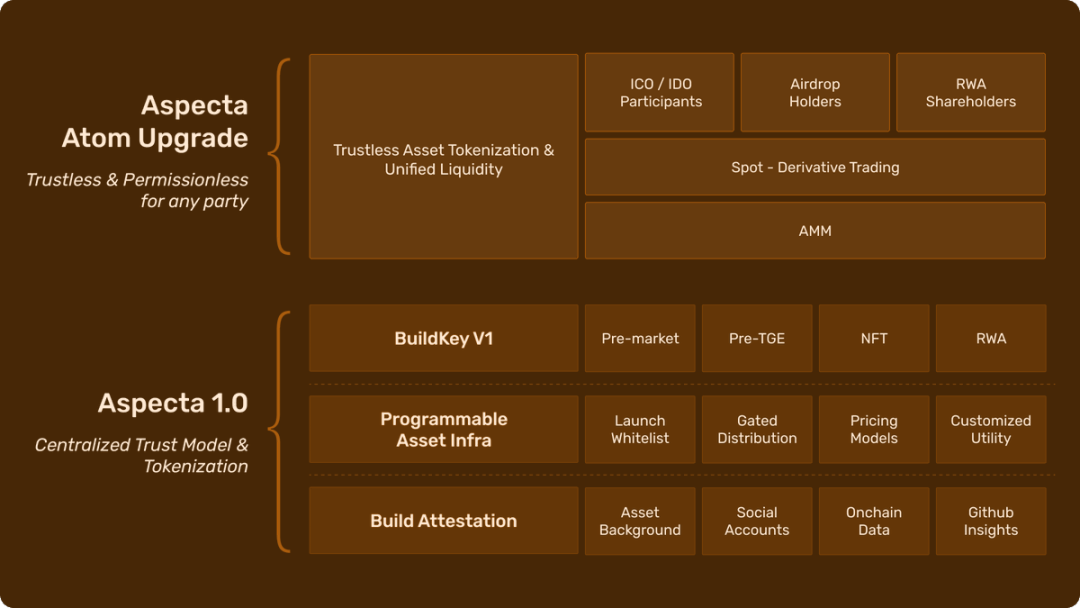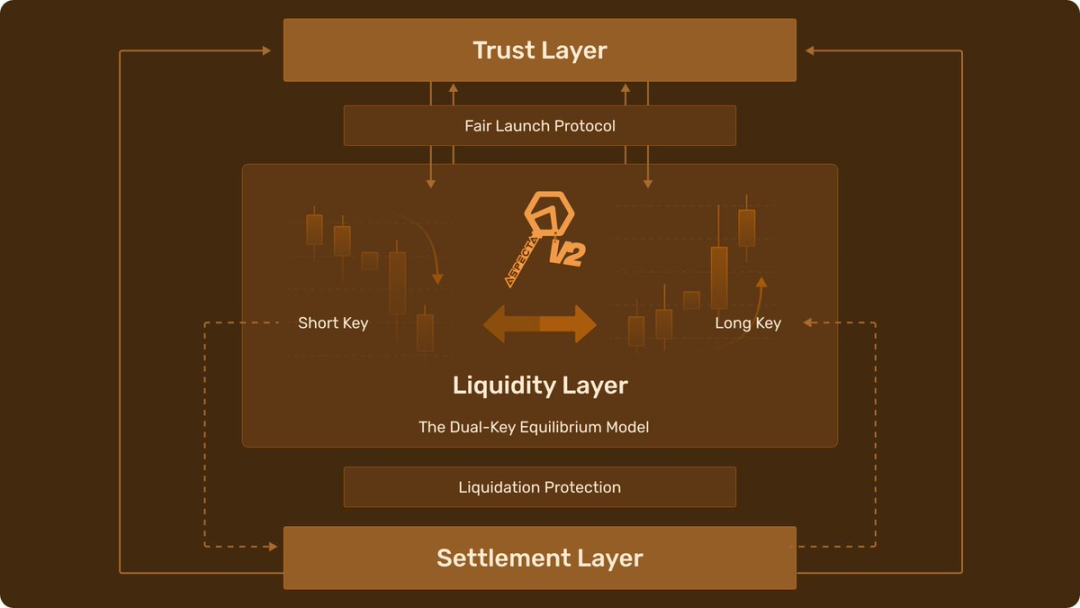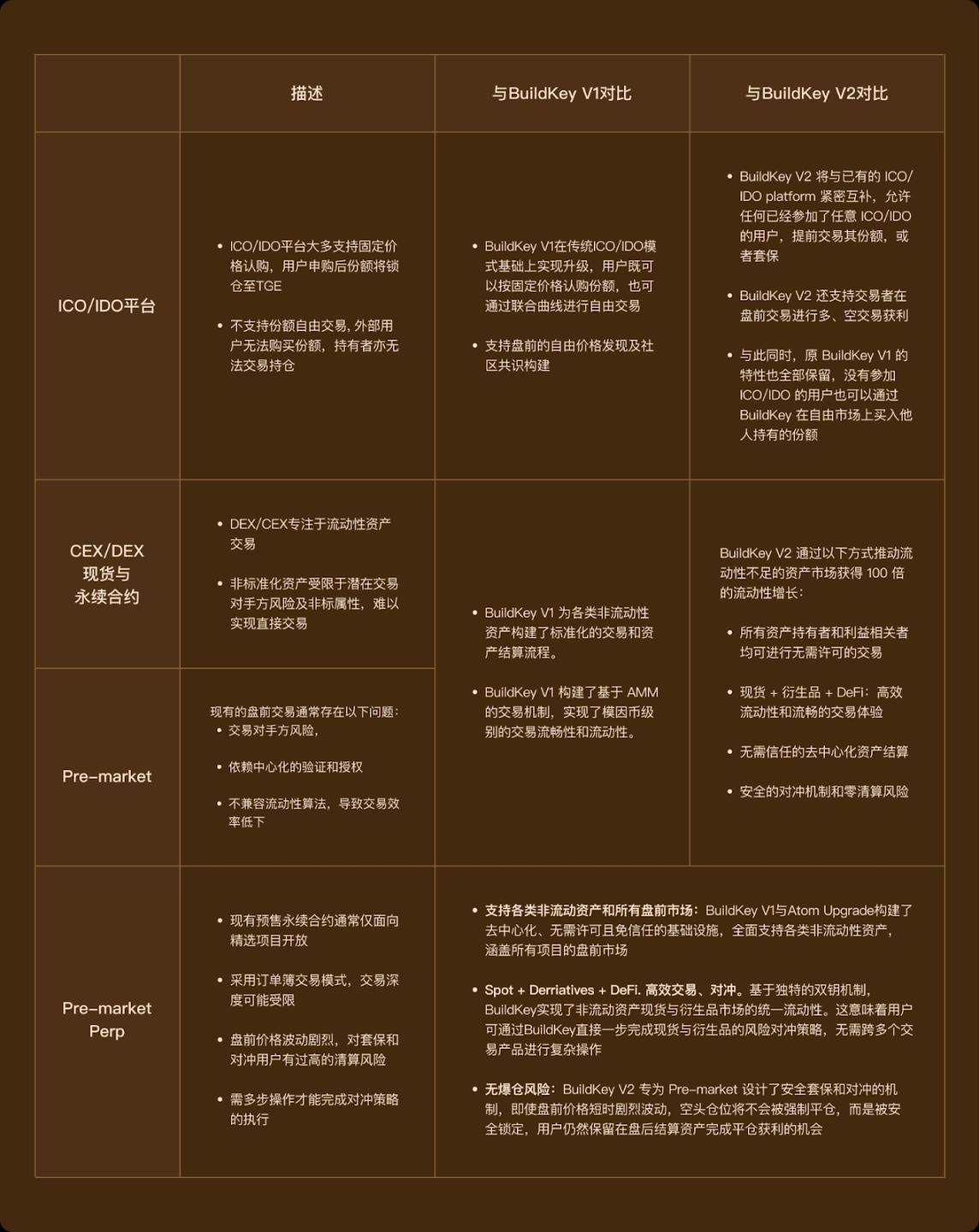Aspecta launches Atom upgrade: 100X potential of illiquid assets - trustless tokenization and universal liquidity
Aspecta launches the Atom Upgrade, creating a new standard for illiquid asset trading based on a brand-new blockchain architecture. This standard is built on the AMM mechanism and integrates spot and derivatives trading for illiquid assets, all within a trustless framework.
Written by: Jack He, Co-Founder of Aspecta
Summary
Since 2023, Aspecta has focused on building universal price discovery infrastructure for illiquid assets. Its product suite includes BuildKey V1, Build Attestation, and Programmable Asset Infra, offering intelligent attestation, public pricing, and liquidity solutions. To date, Aspecta has supported hundreds of millions of dollars in illiquid asset transactions, including various Pre-markets, Pre-TGEs, Locked Tokens, and NFTs.
Existing solutions are based on centralized trust models, requiring complex and lengthy on-chain mapping, trading, and settlement for illiquid assets. The growing trading demand for various illiquid assets (pre-market shares, airdrops, unvested equity/token allocations, etc.) among multiple stakeholders faces two core challenges: [Trustless Asset Tokenization] and [Universal Liquidity].
To address this, Aspecta has introduced the Atom Upgrade, which, through a new blockchain architecture, establishes a new standard for illiquid asset trading based on the AMM mechanism and integrating spot and derivatives trading. This trustless framework solves issues of centralized asset authorization and counterparty risk. This upgrade aims to drive a hundredfold potential growth in the on-chain illiquid asset market, advancing the establishment of trading and liquidity experiences comparable to mainstream assets such as BTC, ETH, and BNB.
1. Overview
Spot and derivatives trading protocols based on ERC-20 assets have become the mainstream paradigm in the blockchain space due to their simplicity, standardization, and scalability. However, illiquid assets such as pre-market shares, airdrops, and unvested equity/token allocations lack unified standards, resulting in poor liquidity. The core pain points are:
- Information opacity, making ownership verification difficult
- Centralization of on-chain tokenization authorization, trading, and settlement
- Inefficient trade matching mechanisms
Building on BuildKey V1, Build Attestation, and Programmable Asset Infra, Aspecta now officially launches the significant Atom Upgrade—BuildKey V2. This version focuses on [Trustless Asset Tokenization] and [Universal Liquidity] to break through the development bottleneck of illiquid assets.

1.1 Trustless Asset Tokenization
The trustless tokenization framework for illiquid assets aims to eliminate reliance on centralized authorization by native asset owners (project teams, companies, etc.), allowing any relevant stakeholder to initiate trades and ensure settlement/payout completion with zero counterparty risk. For example:
- In the pre-TGE stage, how can participants and future airdrop holders trade shares that are not yet liquid?
- When private equity investors face delays or inability to obtain authorization from native asset owners, how can they initiate trades and ensure smooth settlement when a liquidity event occurs?
1.2 Universal Liquidity
Achieving on-chain liquidity for illiquid assets on par with the ERC-20 standard
- Spot - Derivatives - DeFi: Supports spot trading, derivatives (e.g., long, short) trading, and more DeFi compatibility for illiquid assets.
- Liquidity algorithm scalability: Can be extended to be compatible with existing liquidity algorithms and mechanisms, such as AMM, Orderbook, etc., to provide the best liquidity experience.
- Full-cycle connectivity: Efficient trade matching from illiquid to liquid phases.
- Trustless & Permissionless: Allows original asset holders and any stakeholders to initiate and participate in trades, ensuring payout and zero counterparty risk.
Through the Atom Upgrade, Aspecta introduces an innovative blockchain architecture that, within a fully trustless framework, implements a new AMM-based integrated spot and derivatives trading system. This upgrade will bring 100x growth potential to the illiquid asset market, aiming to drive millions of participants and billions in trading volume, establishing a new on-chain financial ecosystem.
2. Aspecta Atom Upgrade
2.1 Overview
The Aspecta Atom Upgrade builds BuildKey V2, a minimalist trading model supported by a Layerized System and the Dual-Key Equilibrium Model. The BuildKey V2 trading process is simple yet powerful, granting illiquid assets trading liquidity and scalability equivalent to ERC-20 tokens, all built on a decentralized, trustless architecture. Through the Aspecta Atom Upgrade, illiquid assets will achieve the following improvements in trading liquidity and scalability:
- Permissionless trading for all stakeholders
Asset stakeholders can trade their holdings without going through centralized, cumbersome authorization processes, such as participants, airdrop holders, and early investors.
- Spot + Derivatives + DeFi: Efficient liquidity and trading experience
Traders can efficiently trade assets through mainstream ERC-20 spot and derivatives trading mechanisms (including order books, AMM, and perpetual contracts).
- Trustless, decentralized asset settlement
The settlement process from on-chain illiquid asset certificates to actual liquid assets is standardized and decentralized. If asset buyers do not receive the actual asset when a liquidity event occurs, the smart contract will automatically compensate the buyer, effectively resolving counterparty risk in a trustless manner.
- Liquidation protection and secure hedging mechanisms
Even if pre-market prices fluctuate sharply in the short term, short positions will not be forcibly liquidated but will be securely locked, allowing users to still have the opportunity to close positions and profit after post-market settlement. This mechanism addresses the unreasonable liquidation risk of short hedging in illiquid assets and pre-market trading.
2.2 Use Case Overview
The Aspecta Atom Upgrade (BuildKey V2) provides various scenarios based on the AMM trading model for different participants:
Opening long positions (trading long BuildKey) to buy future assets:
- Individual token buyers
- Institutions and liquidity funds
- Bullish price speculators
Opening short positions (trading Short BuildKey) to sell future assets:
- Users participating in early asset fundraising (Launchpad, Token/Equity Investment, etc.)
- Users eligible to obtain future liquid assets (airdrop holders, etc.)
- Hedging traders
- Bearish price speculators
Users can go long or short BuildKey to earn profits during the illiquid phase based on the AMM mechanism. Users can also settle (Settlement) when liquidity events (such as TGE, token unlock, IPO, etc.) occur, receiving or redeeming the corresponding liquid assets or BNB.

2.3 System Architecture
The Aspecta Atom Upgrade introduces a closed-loop financial system for the illiquid asset market, consisting of three deeply interconnected layers that form a self-reinforcing economic flywheel. This is not a simple combination of independent functions but a highly unified operating engine: each layer directly powers and secures the next.
The Trust Layer lays the foundation for trading trust. For each short user (claiming to provide future liquid assets), the trust layer collects their margin and, together with the other two layers, operates a decentralized mechanism to manage this margin. This decentralized margin management builds the trustless asset tokenization infrastructure.
The Liquidity Layer acts as the market engine, transforming the group of verified participants into a dynamic market. It relies on the funds and trading activity generated by the trust layer, using margin and returns to provide liquidity. The core of this layer is the Dual-Key Equilibrium Model, which achieves native short exposure without relying on external liquidity pools or oracles, thus establishing a dynamically balanced, self-regulating market for illiquid assets.
On the other hand, the liquidity layer also includes a fair launch protocol that actively eliminates bots and Sybil attacks through fair launch and sniping tax mechanisms.
The Settlement Layer serves as the system's self-executing adjudication body, mechanically executing the logical outcomes of all preceding operations. It directly interacts with the trust layer to release or forfeit margin and redistributes value according to the equilibrium system's final state. This forms a virtuous cycle of value flowing back to compliant participants, thereby consolidating the ecosystem's long-term vitality.

2.4 Core Technologies
This section details the Dual-Key Equilibrium Model and other key technologies in each architectural layer.
2.4.1 Core Architecture: Dual-Key Mechanism
Taking the Pre-market as an example, existing platforms have a structural long bias, leading to information asymmetry and limiting price discovery. The Aspecta Atom Upgrade introduces an innovative mechanism: the Dual-Key Bonding Curve. This mechanism achieves native short risk exposure without relying on external liquidity pools or oracles, creating a dynamically balanced, self-regulating market for illiquid assets.
The protocol issues two interrelated financial instruments:
- Long Key: A synthetic asset representing a fixed proportion (e.g., 0.00001%) of the project's future total token supply. Purchases interact directly with the bonding curve, deterministically pushing the price up.
- Short Key: An innovative synthetic debt position minted by depositing collateral. Each Short Key minted creates and sells a corresponding Long Key to the market, exerting downward pressure on the curve. The profit and loss of Short Key holders are negatively correlated with the Long Key price.
2.4.2 Algorithm-Based Market Equilibrium
This system constructs a closed-loop economic environment, where long and short activities together form a continuously operating price discovery feedback loop. The buying pressure from Long Key holders and the selling pressure from Short Key minting balance each other, forming a dynamic equilibrium that theoretically drives Key prices toward the fair value validated by the community.
2.4.3 Short Position Establishment Mechanism and Risk Management
The short mechanism is the cornerstone of the BuildKey V2 architecture:
- Position establishment: Users open short positions by locking collateral (such as BNB). The protocol algorithmically mints Short Keys and simultaneously sells the corresponding Long Keys synthetically, instantly exerting downward price impact.
- Profit locking and collateral management: Potential profits and initial collateral for short positions are programmatically locked in a non-custodial smart contract vault, with release conditions strictly triggered by preset rules.
- Secure liquidation engine: When a position reaches a deterministic liquidation point (i.e., the locked collateral is insufficient to buy back the minted Long Keys, typically a price doubling event), a secure liquidation is triggered—the short user's position is locked (cannot be closed) before asset settlement but still retains the opportunity to close after asset settlement. On one hand, this design effectively controls systemic risk and protects the integrity of the long pool; on the other hand, unlike contract liquidation, it does not forcibly close users' positions, thus avoiding the risk of short pool liquidation due to short-term price fluctuations. In contrast, existing Pre-Market Perp and other illiquid asset trading, lacking broad spot prices as a reference, are susceptible to short-term manipulation, bringing significant uncertainty for short users.
2.4.4 Settlement Mechanism for Shorts and Longs
Taking Pre-market Token assets as an example, the settlement process after TGE is triggered by immutable smart contract logic:
Short Settlement (TGE to T+2 hours)
Short Key holders must deliver the predetermined amount of project tokens to the contract to unlock collateral and realize profits. The preset exchange rate (e.g., 1 SK = 0.00001% of token supply) is immutable, directly linking Key prices to the project's final value. Failure to deliver results in forfeiture of locked assets, which are redistributed to the long pool as compensation.
Long Settlement (after TGE+2 hours)
Long Key holders can proportionally redeem
- Project tokens delivered by closed short positions
- BNB forfeited by shorts who failed to close
- All remaining BNB liquidity in the pool
This mechanism ensures that long traders are the ultimate beneficiaries in the event of short defaults, creating a closed loop of risk and benefit transmission.
2.4.5 Fair Launch Mechanism
Early Key Allocation Mechanism Based on Splitting/Lottery
At system launch, a deposit phase is initiated, where users deposit funds to bootstrap the initial liquidity of the Bonding Curve. Through a function (splitting or lottery), the system allocates Long Keys to users proportionally to their deposits, establishing a fair and permissionless initial allocation mechanism.
Single Address Hard Cap: Anti-Monopoly Mechanism
To clearly prevent wealth concentration and resist Sybil attacks, the protocol sets a strict and unbypassable upper limit on the number of Long Keys that can be obtained by a single address. This hard cap parameter builds a decentralized holder base from the start of the trading phase, structurally reducing the risk of any single entity manipulating prices.
Dynamic Decay Sniping Tax and Price Adaptation
To address market volatility after launch, BuildKey V2 introduces a time-varying trading tax. In the first five minutes after the pool is activated, all buy trades incur an additional fee. This fee uses a deterministic linear decay model, starting at a preset maximum and dropping to zero at the end of the five-minute window.
This model does not prohibit early trading but introduces a calculable cost-benefit analysis, requiring participants to weigh the advantages of early entry against the economic cost of the tax.
From another perspective, this approach allows users to democratically game the initial price of different assets, enabling adaptive pricing for various assets.
2.5 Comparative Analysis

Based on the Atom Upgrade, Aspecta integrates broader application scenarios into a unified trustless trading framework, encouraging deeper user participation and unlocking the potential for 100x liquidity growth. This expansion will cover multiple asset types—from pre-listing tokens to real-world assets (RWA)—and ultimately foster a massive ecosystem with monthly trading volumes exceeding several billions of dollars.
3. Aspecta 1.0 Review: BuildKey V1, Build Attestation, and Programmable Infra
3.1 Overview
Aspecta 1.0 built a universal price discovery product system for illiquid assets, providing intelligent attestation, public pricing, and liquidity solutions. Its core components include:
- BuildKey V1: A universal framework that abstracts illiquid assets into standardized, programmable trust ERC-20 certificates.
- Programmable Asset Infra: An asset issuance solution for project teams and stakeholders, offering flexible pricing, permission distribution, and customization features, empowering asset development throughout its lifecycle.
- Build Attestation (Aspecta ID) and Build Matrix:
- Aspecta ID: A reputation system for developers and early projects, using AI technology (large language models and graph learning) to process billions of GitHub code records, on-chain data, and multidimensional work data, generating an easily understandable reputation evaluation system.
- Builder Matrix and Builder Economy: Based on Aspecta ID, Aspecta collaborates with Google Developer Group and various blockchain infrastructure partners to identify and support verified developers and early projects, and leverages the BuildKey open price discovery mechanism to help community building and market influence.
3.2 Application Cases
The BuildKey V1 model and Programmable Infra have successfully brought over 30 illiquid/pre-market assets into open on-chain markets, with the open price discovery mechanism achieving an average value return of 3573%. Eight assets achieved over 10x returns, with total trading volume reaching hundreds of millions of dollars.
Aspecta ID has 619,000 registered users (with some overlap with BuildKey users), including over 54,000 developers/projects verified via GitHub and over 19,000 highly skilled developers/projects. It has completed collaborations with over 10 mainstream Web2/Web3 developer ecosystems, including Google Developer Group, BNB Chain, Consensys, and others.
3.3 Case Study: River BuildKey TGE Project in Partnership with Binance Wallet
3.3.1 Overview
On September 18, 2025, Aspecta partnered with Binance Wallet to launch an exclusive TGE model based on BuildKey, promoting the BuildKey standard to a broader user base.
3.3.2 Mechanism Design
- Asset size: 2% of the total $RIVER supply
- Issuance process:
- Phase 1—BuildKey Fair Launch: Deposit BNB to obtain early allocation
- Phase 2—Price Discovery: Trade using BNB via the bonding curve
- Phase 3—Redeem BuildKey for tokens
3.3.3 Results Data
- Deposit phase: Oversubscription reached 99,329.94%, with a total of 100,301.86 BNB deposited
- Trading phase: Key price surged about 800% within minutes of trading start
- Post-TGE performance: BuildKey participants achieved up to 6000% investment return
4. Conclusion
Aspecta 1.0 has already built infrastructure for illiquid assets, covering certification, price discovery, and trading, facilitating hundreds of millions of dollars in trading volume.
Driven by strong market demand, Aspecta has launched the Atom Upgrade, introducing a new blockchain architecture that establishes a unified AMM-based spot and derivatives trading experience within a trustless framework. This architecture realizes [Trustless Asset Tokenization] and [Universal Liquidity], laying the foundation for a potential 100x growth in the illiquid asset market.
Aspecta will continue to enhance its trading infrastructure for illiquid assets, further providing a trading experience comparable to mainstream CEX and DEX spot, perpetual, and derivatives markets. It will keep driving the trillion-dollar illiquid asset market to achieve liquidity and trading efficiency on par with mainstream digital assets such as BTC, ETH, and BNB.